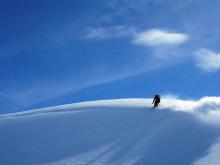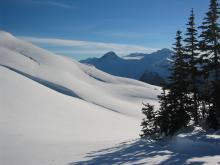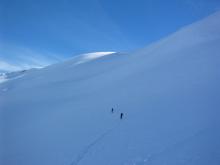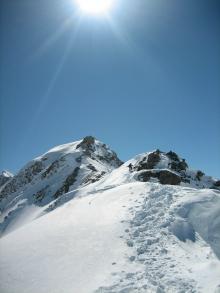Spring Snow. Learn how to make the most of it.
HAT Snow Report for 17 April, 2010
Playing the spring snow game can be fun and YOU CAN HAVE A GREAT TIME from 8.45 until at least 1pm!
SPRING SNOW
Understand the ‘melt-freeze cycles’ and have fun with spring snow! Off-piste spring snow is one of the best things that the Northern French Alps has to offer. With lift access to all slope orientations: east, south, west and then north, you can find it and have fun with little effort.
Melt-freeze Cycles
Once new snow melts during the day and then freezes at night (1 melt-freeze cycle) a few times in succession after a snowfall, the top snow layer begins to form a crust that gets deeper and stronger after each melt allows free water to drip down and re-freeze during the night.
Any given ‘melt-freeze’ layer becomes stronger with each cycle of melting and freezing due to the deeper penetration of each melt during the day, which then adds more depth to the potential frozen layer at night. If untouched, the top of this frozen layer is smooth and solid first thing in the morning, then it becomes progressively softer as the warm sun and increased temperatures melt it as the day goes by.
This process starts on east faces because they get the sun first thing in the morning, then south, then west (north faces at 2500 metres don’t normally get a melt freeze layer on them until late April due to lack of sun).
For good skiing!
The trick is, after a couple of good melt-freeze cycles have created a solid layer on a slope, you need to get on that slope when the snow surface is smooth and solid with only 2 or 3 cm’s of soft melted snow on top (these are generally slopes that have been in the direct sunlight only for an hour or so e.g. an East facing slope at 9 or 10).
Then you need to get off those slopes when the snow surface begins to get too soft and mushy or you’ll start breaking through, which is dangerous for your knees. AND the slope may be unstable due to all the melting - then avalanches can be a problem.
In summery:
After a solid melt-freeze layer has formed and there has been a good melt during the day, it needs to freeze well the night before; the ideal is a cool clear night with minimums of –2 degrees (or lower) at 2000 m. This will allow the melted parts of the layer to freeze solid again from that altitude up. Then, in the morning, you look to get on the east facing slopes first thing, 9 AM, because the sun rises in the east and therefore those slopes get the sun first. Then you move to south facing slopes, then west. Do this right and get some of the best skiing of the season.
Aside from a night that is not cool enough, the only thing that gets in the way of great spring skiing is the nasty ruts in the snow that people leave behind because they either ski spring snow slopes (slopes that get lots of sun in spring: E,S and W) before the melt-freeze layer has formed or they ski the slopes too late when they are too soft and mushy.
Tip of the week:
If you have any questions about the timing of good spring skiing, ask an off-piste guide or instructor around town. They will be happy to explain because their quality of skiing depends on people skiing it right!
Have Fun, Be Safe!
Henry and the HAT Team
See http://www.henrysavalanchetalk.com for the events this week!






